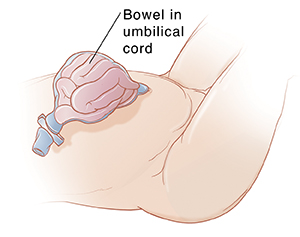Omphalocele and Gastroschisis in the Newborn
Omphalocele and Gastroschisis in the Newborn
Omphalocele and gastroschisis are 2 problems that can occur in newborns. They happen when the body structures that are supposed to hold the bowel (intestines) inside the belly (abdomen) do not form as they should. Normally, the body wall and a membrane enclose the bowel inside the abdomen. With omphalocele and gastroschisis, all or part of the bowel develops outside of the baby’s body instead. Other organs may also be affected. Both of these problems must be fixed with surgery.
Omphalocele |
Gastroschisis |
What is omphalocele?
With omphalocele, the bowel sticks out from the body through a problem in the umbilical cord. A membrane covers the bowel and protects it from damage and germs. A large omphalocele may also happen in other organs that stick out from the body. Omphalocele occurs early in the baby’s development. It may be found on an ultrasound before the baby is born. Even so, the baby can sometimes be delivered vaginally.
What is gastroschisis?
With gastroschisis, the bowel comes out of the abdomen through an abnormal opening in the abdominal wall. Other organs may come through as well. There is no membrane covering to protect these organs. This means they’re more likely to become damaged or infected. If your healthcare provider sees gastroschisis on an ultrasound, your baby will probably need to be delivered by cesarean section. This helps lessen damage to the bowel.
How are the problems treated?
Omphalocele and gastroschisis both must be treated with surgery. This often takes place the day the baby is born. Treatment may involve the following:
The surgeon moves the bowel and other organs back into the abdomen. The surgeon closes the area of skin where they came through.
If the bowel is damaged, the surgeon may remove part of it before it’s put back into the abdomen. The surgeon then reconnects the healthy ends of the bowel.
In some cases, the baby’s abdomen is too small to hold all the organs. The surgeon then moves the organs back gradually. This gives the abdomen time to grow. More than one surgery may be needed.
A healthcare provider will feed your baby through an IV (intravenous) line until the problem is fixed. IV feeding may continue for some time afterward. Your baby will stay in the neonatal intensive care unit during this time.
What are the long-term effects?
The long-term effects on your baby may depend on the size of the defect. It will also depend on whether your baby other physical problems at birth and whether any of the bowel must be removed. Long-term feeding problems are possible. But most of these get better over time. Talk with your healthcare provider about how your baby is likely to progress.
Updated:
August 14, 2018
Sources:
Gastroschisis. UpToDate., Omphalocele. UpToDate.
Reviewed By:
Freeborn, Donna, PhD, CNM, FNP,Images reviewed by StayWell medical illustration team.,Lehrer, Jenifer, MD

